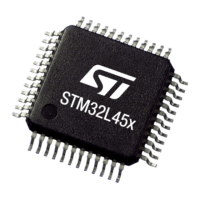Note: The above-described safety mechanisms addresses the DSI interface included in STM32 MCUs, including PHY.
Because actual capability of correct physical signal generation to drive the connected monitor is not addressed
by these safety mechanisms, in case such feature is considered safety relevant, End user is warned to evaluate
the adoption of adequate system-level measures.
3.6.27 Touch sensing controller (TSC)
Table 97. TSC_SM_0
SM CODE TSC_SM_0
Description Periodic read-back of configuration registers
Ownership End user
Detailed implementation
This method must be applied to TSC configuration registers.
Detailed information on the implementation of this method can be found in
Section 3.6.14 Extended interrupt and events controller (EXTI).
Error reporting Refer to NVIC_SM_0
Fault detection time Refer to NVIC_SM_0
Addressed fault model Refer to NVIC_SM_0
Dependency on Device configuration Refer to NVIC_SM_0
Initialization Refer to NVIC_SM_0
Periodicity Refer to NVIC_SM_0
Test for the diagnostic Refer to NVIC_SM_0
Multiple-fault protection Refer to NVIC_SM_0
Recommendations and known limitations Refer to NVIC_SM_0
Table 98. TSC_SM_1
SM CODE TSC_SM_1
Description Multiple acquisition by Application software
Ownership End user
Detailed implementation
This method implements a timing information redundancy by executing multiple acquisitions
on TSC input data. Multiple acquisition data are then used to determine the acquisition correct
state.
This method overlaps on the native features of the TSC module of counting events to ensure
a stable acquisition against external noise.
Error reporting Depends on implementation
Fault detection time Depends on implementation
Addressed fault model Transient
Dependency on Device configuration None
Initialization Depends on implementation
Periodicity Continuous
Test for the diagnostic Not applicable
Multiple-fault protection CPU_SM_0: Periodic core self-test software
Recommendations and known limitations None
UM2305
Hardware and software diagnostics
UM2305 - Rev 10
page 57/110

